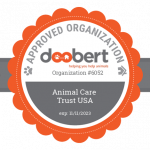 How do you avoid buying pet products that contain toxic chemicals? I asked myself this question recently and found our show’s guest, Leigh Matthews with LeafScore. LeafScore is a website devoted to fighting climate change by helping consumers make greener purchasing decisions. This has never been more important than now.
How do you avoid buying pet products that contain toxic chemicals? I asked myself this question recently and found our show’s guest, Leigh Matthews with LeafScore. LeafScore is a website devoted to fighting climate change by helping consumers make greener purchasing decisions. This has never been more important than now.
At LeafScore, they believe that quality follows sustainability. As a result, generally the best and longest lasting products are almost always made with sustainable, natural, nontoxic and organic ingredients and materials. When you purchase from companies that support the planet, you “vote with your dollars” by putting pressure on manufacturers to factor in the environment, not just their bottom line.
LeafScore is reader supported. When you purchase a product through one of the links on their site, they earn a small affiliate commission. Then they donate 10% of profits to America Forests, one of the oldest conservancies in the United States. For every dollar they donate, American Forests plants one tree. Their goals is to plan 1,000,000 trees and play a role in the rise of climate change.
Leigh taught us all kinds of interesting things about the products we expose our pets to. Most of what we learned was disturbing – we need to do a much better job to ensure we are not exposing our pets to products, toxins and chemicals that can do them grave harm. I recently purchased some inexpensive fabric leaves for some Fall decorating, only to spend $1,200 at the vet and risk the life of my loved dog, Darla, when she ate some. Now I have a good excuse to say, “No more holiday decorating for me!”
But how do you know if a product is safe? First and foremost, check out the “Pet” section at LeafScore. They have information and products you can feel confident giving to your pet. They look for healthy, non-toxic products to help pet parents navigate the world of eco-friendly toys and food. I was interested to learn there are lots of products made from hemp that also make good pet toys. As for bedding, look for certified organic products that are handmade in GOLS (Global Organic Latex Standard) and GOTS (Global Organic Textile Standard) factories.
Our pets share the same home environment we do and may have an even greater exposure to chemicals and dangerous toxins because of the nature way they explore their environment with their mouths or their proximity to dusty or dirty floors. Not only can chemicals in pet products be dangerous but bedding that is made with non-organic cotton or synthetic fabrics can also expose them to toxins.
Our pets can be seen as sentinels for exposure to toxic chemicals and the proof is in the rise of cancers in both dogs and cats. Our pets can suffer from many of the same diseases and health issues we face. Persistent organic pollutants (POP) can include a host of chemical substances that have been found in dogs diagnosed for mammary adenocarcinoma. POPS accumulate the higher up you go in the food chain. Therefore, animals that eat meat are more likely to ingest higher amounts of toxic chemicals.
Leigh shared that Michigan-based Ecology Center has tested hundreds of pet products including tennis balls, pet beds, collars and leashes. Almost half of the products tested had detectable levels of hazardous chemicals including heavy metals such as arsenic, lead, bromine and chlorine. One product that many dogs enjoy is a good tennis ball. However, Leigh reports lead has been found in 48% of tennis balls tested.
Although some pet retailers claim to set their own standards for pet product safety, most of these standards and testing methods are not public, nor are they consistent across the retail industry. Another problem is that the Consumer Products Safety Commission (CPSC) has no jurisdiction over pet products. As a result, you might consider purchasing products that are considered safe for children as opposed to animals. It won’t be fool proof but may give some pet parents more certainty in their choice of products that may be safe for pets.
Yet, this can be a double–edged sword because small parts or decorations can cause your pet to choke and stain resistant compounds or fire retardants should be avoided because of their chemical content. A toy I recently purchased for my dogs that I thought might be safe because it had no squeaker turned out to be potentially deadly when I discovered the plastic noise maker was filled with a cotton type product and held together with multiple rubber bands! I’m grateful I discovered this before my dogs ingested it or that would have been another expensive visit to the vet. And, potentially deadly. I now have a strict rule against stuffed toys of any sort – all are subjected to surgery upon entry to my home where all their insides and small parts are removed before sharing.
Leigh’s recommendation in general is to avoid buying stuffed or fabric toys made in China or other parts of Asia where manufacturing safety standards are much lower than in the United States. And, only buy toys intended for dogs or cats or children under the age of 36 months.
It seems like the list of potentially harmful toys and products our pets come into contact with on a regular basis is endless. As pet parents we must be vigilant to be sure our loved pets are given only toys, treats, bedding, collars and leashes that cannot do them harm.
A big thank you to Leigh and the folks at LeafScore who are dedicated to providing us with information to keep our pets and our families safe.


